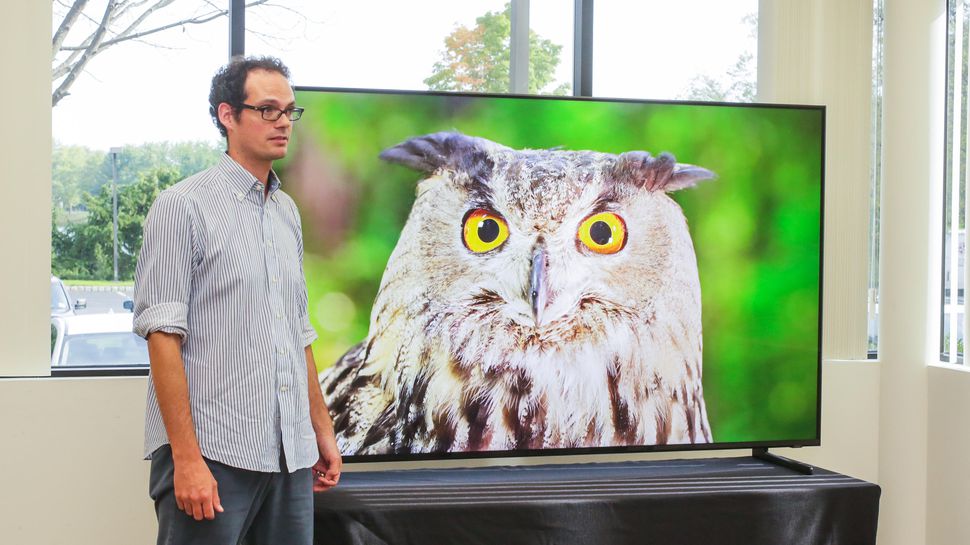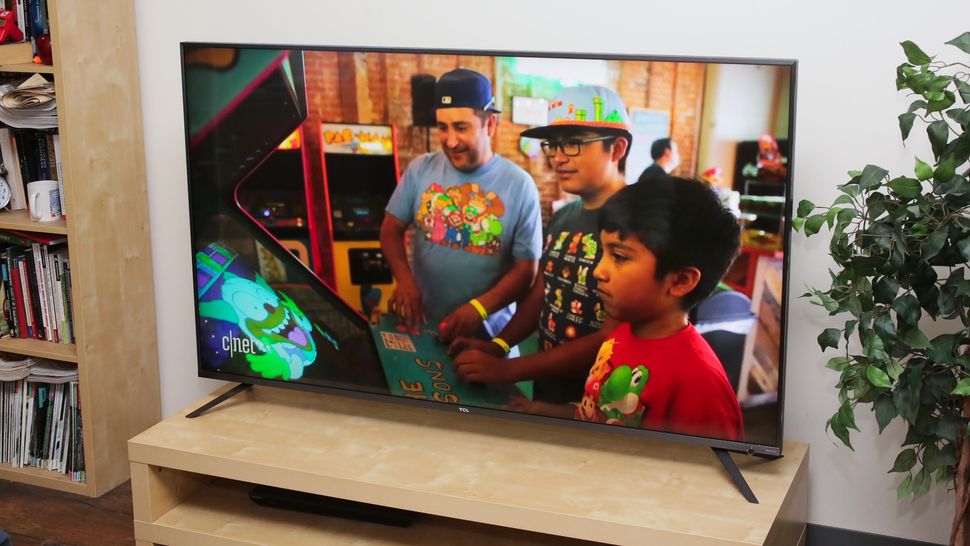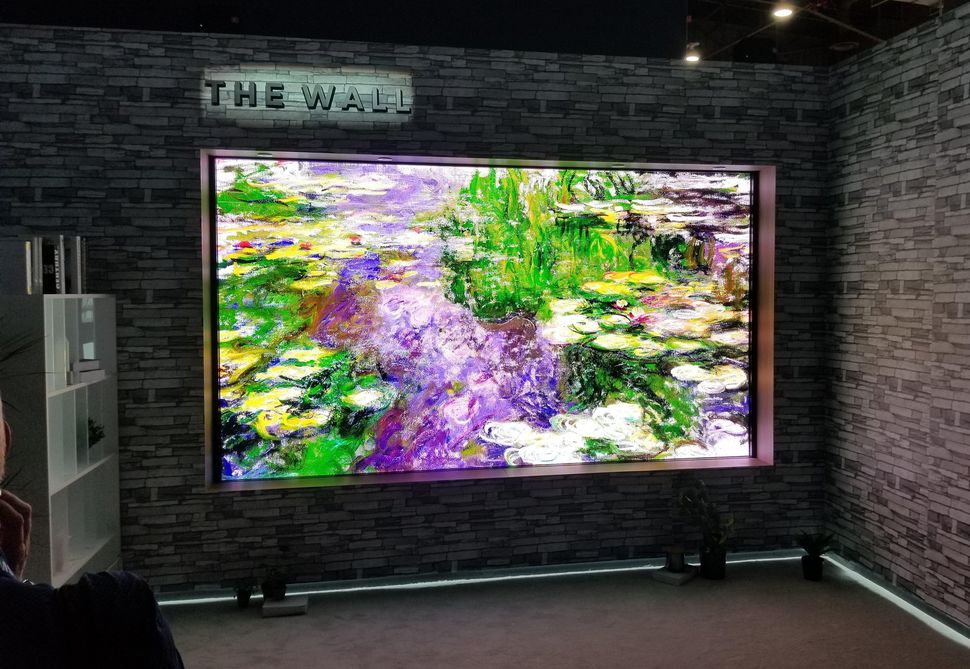Ready or not, the 2019 International CES — aka Nerds in Vegas — is just around the corner. And for TV hardware nerds like me, it’s like a second Christmas.
CES is the place where TV makers unveil their latest creations, both ‘stuff we’re going to sell this year’ and ‘wacky concepts and new tech we may never sell, but looks hella cool.’ The massive booths and sprawling show floor lend themselves to big screens used in creative ways, which helps explain why CES seems more about televisions than any other kind of gadget.
So what TVs can you expect at CES 2019? I have some educated guesses. In fact, most of the TV makers have already told me about a lot of the stuff they’re gonna have at the show. I can’t officially reveal it yet, but what you’re about to read provides a pretty good approximation of what I know. That said, there’s always a surprise or two in store.
Rollin’ with the OLED homies
Frankly, I was as surprised as anyone to learn that the coolest concept TV of last year’s CES — an OLED TV that can roll up like a poster to disappear inside a trim, little box — is reportedly going on sale in 2019.
LG’s rollable OLED TV could ship in 2019 https://t.co/PFQosCf6BR pic.twitter.com/JZHid1Yp7Z
— David Katzmaier (@dkatzmaier)
Why? Aside from the obvious answer of ‘because they can,’ a roll-up TV is truly useful. As I wrote last year: ‘One of the worst things about big-screen TVs is the necessity for a massive swath of black plastic taking up a chunk of wall when it’s turned off. With a rollable TV that’s no longer an issue, and that practicality is the main reason I think LG Display will want to perfect this technology and help manufacturers bring it to market sooner rather than later.’
Looks like ‘sooner’ will win.
8K for sale! Get yer 8K TVs, rich guy!
Samsung just started selling the first 8K TV in the US, the $15,000 85-inch Q900, and LG showed an 88-inch 8K OLED at IFA in Berlin, targeting a 2019 sale date. At CES 2019 you can expect more higher-than-4K-resolution TVs to be announced, not only from Samsung (which is already selling smaller, cheaper 8K TVs in Europe) and LG, but perhaps from Sony, Vizio, TCL and Hisense.
All of these TVs will likely be very expensive in 2019, and I don’t expect the resolution increase alone to be worth the cost. But over the next few years, 8K will likely come down in price and start to become the default resolution for very large screen sizes, much like 4K is already the default for TVs 55 inches and above.

Bigger and higher deffer
Speaking of very large screens:
‘The main trend is clearly big screen TVs, really big screens, continuing to be a growing part of market,’ says Stephen Baker, vice president of industry analysis at NPD Group. ‘And of course you saw a manifestation of that during Thanksgiving with the $398 65-inch TVs Walmart was selling.’
Here’s Baker’s quarterly sales numbers for TVs sized 65 inches and above, showing a gradual yet steady increase nearly every quarter (Q4 2018 numbers were not available at press time).
Market share of 65-inch and larger TVs
| Q1 2016 | 6% |
|---|---|
| Q2 2016 | 6% |
| Q3 2016 | 7% |
| Q4 2016 | 8% |
| Q1 2017 | 9% |
| Q2 2017 | 9% |
| Q3 2017 | 9% |
| Q4 2017 | 11% |
| Q1 2018 | 11% |
| Q2 2018 | 13% |
| Q3 2018 | 12% |
TCL takes share, Samsung stays strong
I also asked Baker for recent market share numbers in general, in particular for TCL. The China-based manufacturer always seems to top Amazon’s best-selling TVs charts with its Roku TVs; its sets were featured in numerous Black Friday and Cyber Monday sales (including the 65-inch TV Baker cited), and its 6 series was my favorite TV of the year for the money.

Baker said TCL has grown by 60 percent for each of the last two years. Here’s his latest overall market share numbers for 2018 (through January through October, the most recent month he had available) compared to the same period in the past two years, in both unit share (number of actual TVs sold) and revenue share (the dollar value of TVs sold).
It shows that while TCL is growing fast, most of its share is in less-expensive TVs. Meanwhile perennial market leader Samsung continues to dominate, albeit less-so than in recent years. It lost 4% of unit share but only 2% of dollar share, indicating that it’s selling fewer TVs overall but still crushing its rivals in high-end TV sales.
US TV market share by units sold, Jan. – Oct.
| Brand | 2016 | 2017 | 2018 |
|---|---|---|---|
| Samsung | 26% | 25% | 22% |
| Vizio | 21% | 19% | 14% |
| TCL | 4% | 9% | 13% |
| LG | 9% | 9% | 10% |
| Element | 7% | 6% | 7% |
US TV market share by revenue (Jan. – Oct.)
| Brand | 2016 | 2017 | 2018 |
|---|---|---|---|
| Samsung | 37% | 35% | 35% |
| LG | 12% | 15% | 15% |
| Vizio | 19% | 15% | 11% |
| Sony | 11% | 12% | 10% |
| TCL | 2% | 5% | 9% |
Keep talking to the TV
Alexa and Google Assistant have been built into TV remotes for the last few years, and more and more sets also support hands-free (no remote required) voice commands if you own an Echo, Google Home, Sonos One or other smart speaker. For 2019 I won’t be surprised to see TV makers take it a step further: by building a far-field mic into the TV itself so you don’t even need a separate speaker.
Toshiba says most of its 2019 TVs for the European market will have these so-called far-field mics for hands-free Alexa control. It seems like a natural next step for 2019 Amazon Fire TV Edition sets too, especially given how well Amazon’s Fire TV Cube is able to ‘listen’ without being affected by the blare of TV speakers. Look for other TV makers to follow suit.
‘AI’ meets picture-quality enhancements
It’s tough to market picture quality. Terms like ‘full-array local dimming’ and ‘HDR10 and Dolby Vision high dynamic range’ don’t exactly roll off the tongue. You know what does? ‘AI.’
LG has already associated artificial intelligence with its built-in Google Assistant, but the next step is telling buyers that AI algorithms can improve picture quality. Samsung got that ball rolling with its Q900 8K TV — it says AI helps improve the necessary upconversion from 4K to 8K by using algorithms to examine a dataset of 4K video and better adapt it to 8K — and where Samsung’s marketing goes, others follow.

Micro-LED: Another brick in The Wall against OLED
Flat, stiff non-8K OLED TVs — which continue to deliver the best picture quality available — are selling better than ever. Baker says OLED’s share of TVs over $1,000 has grown to 15 percent in 2018, up from 11 percent in 2017.
That means companies that don’t sell OLED, in particular Samsung, are doing their darnedest to come up with an alternative. The high-end Q9 QLED came closer than ever, but even it can’t escape the inherent issues of LCD-based displays. Enter Micro LED, which Samsung introduced last year with The Wall — a 146-inch modular ‘TV’ that made a big splash at CES last year. It promises all of the great picture quality of OLED (perfect black levels, improved-off-axis viewing) along with superior brightness and less of a propensity for burn-in.
This year it could come closer to market in smaller sizes. The technology is still a few years away, however, so I don’t expect a consumer version to appear this year.
Wait, what about HDMI 2.1?
Some folks might be wondering whether the TVs of 2019 will finally support the latest HDMI standard, 2.1, which delivers higher bandwidth for certain kinds of 8K video, among other benefits. I’d be surprised if any of the TVs announced at the show, or shipping in the first half of the year, fully comply with the HDMI 2.1 standard — although some TV makers might claim HDMI 2.1 compliance anyway.
The thing is: it’s not a big deal unless you’re buying an 8K TV. For just about all of the 4K video available today, the HDMI connections on current TVs are sufficient.
Samsung’s 8K Q900, for example, can handle some HDMI 2.1 extras, specifically Variable Refresh Rate, High Frame Rate (HFR) and Dynamic HDR. The TV’s HDMI inputs will not handle 8K resolutions at 60 frames per second, however, maxing out at 8K/30. Once 8K/60 content from HDMI devices available — most likely from PCs first — that might be an issue.
We’ll be there
My boldest predictions yet: I’ll be at CES to sort through all the new screens in person, and there’s gonna be a lot of ’em. Follow us at @CNET for the latest CES news in general, and me @dkatzmaier for TV tech specifically. Should be fun!
